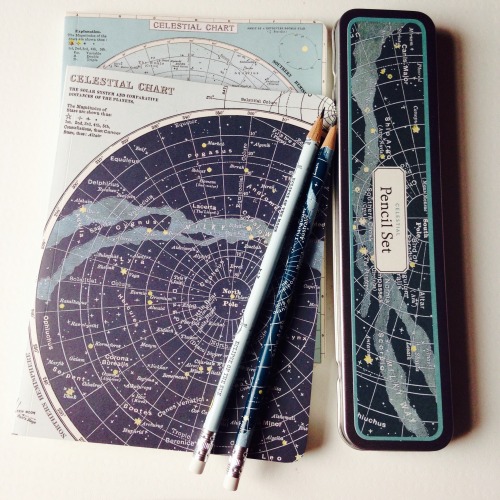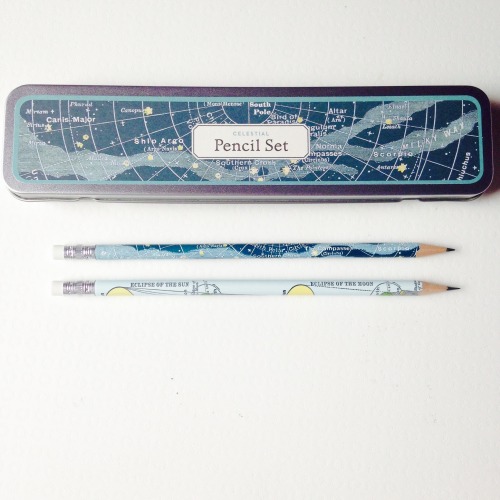There Is No End To My Biology Notes… But Hey, Being An Artist Helps.


There is no end to my biology notes… But hey, being an artist helps.
More Posts from Swirlspill-study and Others

Physics exam in two days!!!

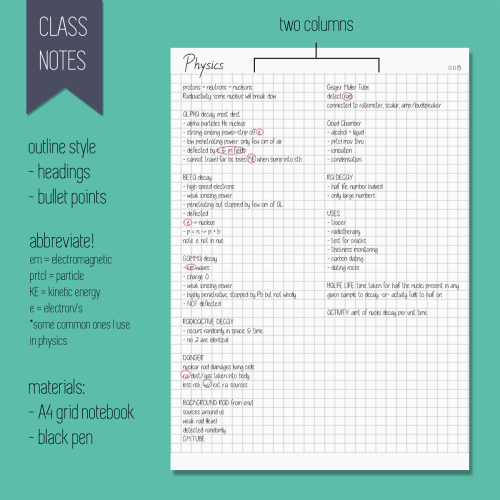
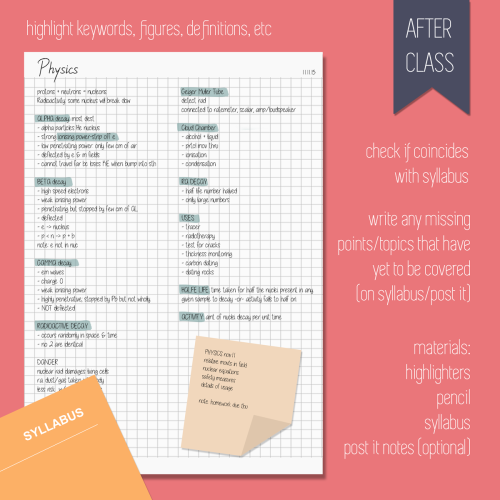
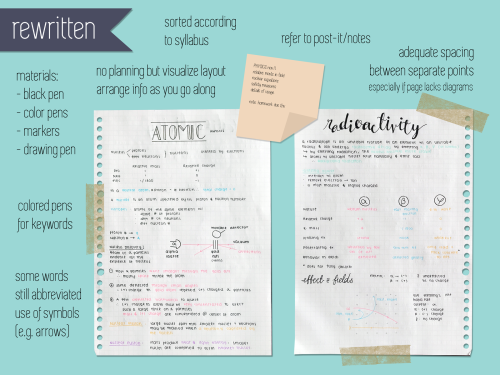
Note-Taking
Hey guys! So I’ve been receiving questions regarding my note-taking style and strategy for quite some time now but I believe I have never answered them in detail. The good news is, I finally decided to make a post about this (plus, I had fun making the graphics :D). Note that I am a visual learner, so my note-taking methods may not be effective for some of you, but I hope you can all learn something.
Class Notes
I only use one notebook for all my class notes, an A4 grid notebook whose pages I divide into two columns.
I use the outline method for in-class notes, which means I write information chronologically, in the order that they are taught. Some teachers do not have properly structured presentations/lessons (good thing my physics teacher does) so when in need, I use arrows to connect related information.
Abbreviations to me are one of the most important things to master when taking notes. I personally make them up as I go along. Some examples of abbreviations I use are:
w/c - which
w/ - with
cpd - compound
envt - environment
digenz - digestive enzyme
It might be confusing, but to me, knowing the context and part of speech are enough for all abbreviations to be comprehended.
Here’s an example: ‘Indonesia’s tsunami pre-warning system is made up of two types of components’ could become ‘Indo’s snmi pre-warn sys 2 type comp’.
After Class
The first thing I would do is highlight keywords and terminology (and sometimes formulas). For physics, since my teacher is relatively succinct, I don’t really highlight, but for humanities and biology, I look for words that would be expected by a mark scheme, words that are crucial to the understanding of each particular piece of information.
I would then check if the material taught coincides with the syllabus, and if not, note down any points that are missing or have yet to be taught. You could write these on a post it or on the syllabus itself, but I prefer to highlight the syllabus’ pdf file.
Rewritten Notes
My rewritten notes are arranged based on the order they appear in the syllabus unless there are pieces of information that are related to more than one topic.
I use a black pen for rewriting notes as well as colored pens to write keywords and terminology only. I know some people who write whole sentences in colored pens but to me that is ineffective; we all have our own learning styles. When making tables, I usually use different colors for different columns (see the table for different types of radiation above) which is most often the color I associate with each word. For example, water would be blue, ocean would be a darker shade, ice would be a lighter shade, and water vapor would be purple.
I still abbreviate words in my rewritten notes, but they’re not as condensed as the ones in my class notes. Another thing I find helpful is leaving a bit of space between separate points especially if the page doesn’t have a lot of diagrams. I can’t think linearly, so I can’t remember super lengthy bullet points.
I use mildliners and a drawing pen to make my diagrams (more of these in my biology notes) but I only start with pencil if it’s a complex diagram. I rarely highlight my rewritten notes, but even if I do, it’s usually only the headings and formulas.
I don’t have a rough draft for my notes, but I try to visualize the layout. I try to alternate between words and pictures/diagrams so that when I’m sitting for an exam, all I have to do is imagine that I’m looking at that page and I can remember where everything is.
Well, that’s all from me. I hope that this information could be of some use to every single one of you. Don’t hesitate to ask me questions if you’re confused about note-taking or any other problems you might have :)

Psychology is crazy overwhelming but so interesting. I wish I could major in such a fascinating field but I need something that I can obtain more connection and success with. This is one of the subjects where my motivation and organization skills are on point, I hope I can feel this passion with other subjects. (IG POST)
tips for graduate grants, awards, & fellowships
hello! usual disclaimer applies: i’m a phd student, not an expert. i work in an english department with a medical humanities project, so this advice may not apply to STEM folks, undergraduates, or to all fellowships or grants. use your own common sense & discretion. beneath the cut:
finding the money
keeping track of the money
actually applying for the money, feat. the world’s longest treatise on project proposals
soliciting (& receiving) letters of rec
Keep reading
Literally do your work as soon as you know it exists. If you get homework, do it during your free or when you get home or on the train if you really want to, on the day you get it. Just got set an assignment? Get the draft done that weekend. It doesn’t have to be amazing and absolutely ready to send in, it just needs to exist. Just got sent an email? Reply when you see it. If you’re not sure how to response to it, write Dear (), leave a gap and then write Regards () and keep that in your drafts. Set a reminder on your computer or write the reminder on a sticky note that you’ve got that sitting in your drafts and you need to send it off in the next 24 hours. Need to clean your room? Don’t spend time thinking or planning how you’re going to clean it or how you’re going to change up the space in the process, just pick stuff up and put it where it should be until everything’s in order. Done. Seriously dude, when a task arises as an issue, tackle it as soon as you realise it exists. Remember, it doesn’t need to be amazing it just needs to be done. So, when the due date of the task creeps closer, you can go back, work with what you have and make it the quality you want it to be.
-
 sedusadrakaina liked this · 1 year ago
sedusadrakaina liked this · 1 year ago -
 thejoshlange liked this · 1 year ago
thejoshlange liked this · 1 year ago -
 tryingtobeawriter15 liked this · 2 years ago
tryingtobeawriter15 liked this · 2 years ago -
 herbygrad reblogged this · 4 years ago
herbygrad reblogged this · 4 years ago -
 herbygrad liked this · 4 years ago
herbygrad liked this · 4 years ago -
 greyglasshouse liked this · 4 years ago
greyglasshouse liked this · 4 years ago -
 kawaii-puffin-lover liked this · 5 years ago
kawaii-puffin-lover liked this · 5 years ago -
 myeducationatstudyblr reblogged this · 5 years ago
myeducationatstudyblr reblogged this · 5 years ago -
 basicallyquen liked this · 5 years ago
basicallyquen liked this · 5 years ago -
 kenymero liked this · 5 years ago
kenymero liked this · 5 years ago -
 actual-changeling liked this · 5 years ago
actual-changeling liked this · 5 years ago -
 aatreyosikdar123-blog liked this · 5 years ago
aatreyosikdar123-blog liked this · 5 years ago -
 anjjolett-blog liked this · 6 years ago
anjjolett-blog liked this · 6 years ago -
 schoolsucksdude reblogged this · 6 years ago
schoolsucksdude reblogged this · 6 years ago -
 tonvstarkly liked this · 6 years ago
tonvstarkly liked this · 6 years ago -
 carterjam-blog liked this · 6 years ago
carterjam-blog liked this · 6 years ago -
 krayolacorpse liked this · 6 years ago
krayolacorpse liked this · 6 years ago -
 krayolacorpse reblogged this · 6 years ago
krayolacorpse reblogged this · 6 years ago -
 wierdhumanoid liked this · 7 years ago
wierdhumanoid liked this · 7 years ago -
 slowlylosingmypatience liked this · 7 years ago
slowlylosingmypatience liked this · 7 years ago -
 deafeningstudents3414 reblogged this · 7 years ago
deafeningstudents3414 reblogged this · 7 years ago -
 deafeningstudents3414 liked this · 7 years ago
deafeningstudents3414 liked this · 7 years ago -
 angel--69--v reblogged this · 7 years ago
angel--69--v reblogged this · 7 years ago -
 angel--69--v liked this · 7 years ago
angel--69--v liked this · 7 years ago -
 swirlspill-study reblogged this · 7 years ago
swirlspill-study reblogged this · 7 years ago -
 slucandid reblogged this · 7 years ago
slucandid reblogged this · 7 years ago -
 pastelpause reblogged this · 7 years ago
pastelpause reblogged this · 7 years ago -
 knowledgestudies reblogged this · 7 years ago
knowledgestudies reblogged this · 7 years ago -
 knowledgestudies liked this · 7 years ago
knowledgestudies liked this · 7 years ago -
 tzipora-art liked this · 7 years ago
tzipora-art liked this · 7 years ago -
 coyote-clawz liked this · 7 years ago
coyote-clawz liked this · 7 years ago -
 kira-and-kats liked this · 7 years ago
kira-and-kats liked this · 7 years ago -
 teaandcookiesstudy reblogged this · 7 years ago
teaandcookiesstudy reblogged this · 7 years ago -
 ginsengstudy liked this · 7 years ago
ginsengstudy liked this · 7 years ago -
 forrest-tea liked this · 7 years ago
forrest-tea liked this · 7 years ago
a study blog for collected references, advice, and inspiration
267 posts

